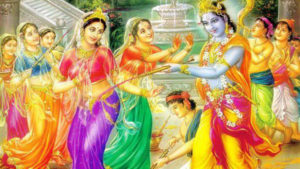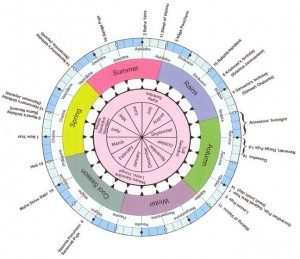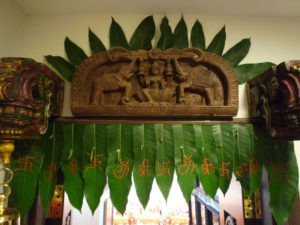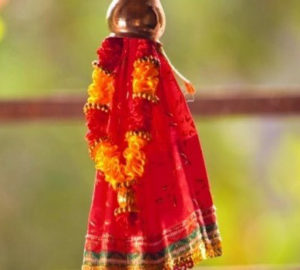On the arrival of the spring, trees shed their old leaves and sprout all over and the extreme climate gives way to a pleasant one. Trees grow prosperous with fragrant flowers and attract flocks of excited birds and insects. Spring implies ‘love is in the air’ for all. Many animals and birds flock and breed at this time. Spring is most suitable for travel, outings and outdoor celebrations.
The recognition of the divine in all existence unfolded within Indians a higher dimension to their understanding of nature’s subtleties. Their observations were documented not just in scholarly treatises, but also in the layman’s life through the rituals, festivities, customs and artistic expressions. Festivals in particular have been the richest examples for the bond that Indians share with nature. Most of the age-old rituals and festivals of India are indeed celebration of seasons.
Festivals of India have been the eternal platforms for showcasing the best aspects of Indian life. Divine contemplation packaged in aesthetic expressions, make Indian festivals appealing to one and all. Profound philosophy, mystic tales, suggestive symbolism, ardent devotion combined with tasty food, spectacular wardrobes, interesting customs, boundless creativity, music, dance, poetry, drama, sports and pastimes, trade, social bonding and many more get highlighted at their very best during festivals.
Yugadi, the Core of Vasantotsava
The Spring Festival or Vasantotsava, an almost two-month long celebration, was for ages the grandest festival season for every Indian. Till the Islamic invasions followed by centuries of tyrannical foreign rule trampled upon public celebrations and severed the royal patronage they received hitherto, Vasantotsava was marked with extremely grand celebrations and mass feastings in every part of India. Countless references to Vasantotsava celebrations can be found scattered across Vedic, Pouranic, classical and folk literature. The happiest moments in life, to this day, are metaphorically termed as vasanta-kaala!
Vasantotsava comprised a series of celebrations of which Sri Panchami, Holi, Phalguna Purnima, Yugadi, Chitrapurnima, etc., are still in vogue. Manmatha, the God of Love and a form of Lord Vishnu along with Bhudevi, a personification of Goddess Lakhsmi and Surya and Chandra, the ‘Pratyaksha Brahma’s (the Visible Deities) are worshipped in Vasanta.
Vasantotsava has since time immemorial been the greatest platform for poets, musicians, dancers, actors and their connoisseurs and patrons. The exclusive Vasanta-mantapas and spacious courtyards in ancient temples and palaces, speak of the mega celebrations they hosted in the past. In the past, the kings and patrons hosted assemblies for scholars, poetry, music, dance, drama etc., Native sports events and lovely games and pastimes attracted crowds all day. Mass Annadaanam (feasts) and charity continued all day. Palaces, buildings and houses were decked with flags, banners and buntings symbolizing their clans and accomplishments.
Yugaadi is the most prominent day in the nearly two-month long Vasantotsava.
Yugadi
The beginning of the Yuga (year or age) is known as Yugadi. This festival, once the most spectacular of all celebrations in ancient and medieval India remains a very popular Pan-India celebration. There are two Panchanga paddhatis (conventional calendar): the Souramaana and the Chandramaana Panchangas. These are different in approach but supplementary each other. People of the coastal belts mostly follow the souramana panchanga (calendar based on the sun’s zodiac positions) and others follow the Chandramaana panchanga. This makes sense because, people living on sea coasts, can make clearer observations of the sun. Accordingly Souramaana Yugadi begins when the Ashwini nakshatra (Star), the first in the nakshatra series, falls in spring. The Chandramaana panchanga begins the year on the first day (Pratipat) of the Shukla Paksha (the bright fortnight). Either way, for all Indians, every year starts and ends in the pleasant and colourful spring season.
Calendar Switch
Till the Gregorian calendar arrived, most communities across the world celebrated their new-year celebrations typically in the spring season. Designing of the Gregorian calendar was obviously a successful attempt by the European invaders and the Church to ‘historicize’ the birth of Jesus. They ‘standardized’ the birth and death of Christ through their AD (Anno Domini) and BC (Before Christ) conceptions and imposed it on the people they colonized.
Eventually, we in India, have gotten so used to this calendar that we are not comfortable using our own calendar systems for any practical purpose! Worse is the fact that we are getting more and more incapable of comprehending or tracing back anything that has not been documented in the Gregorian calendar format. This led to the modern superstition that "anything not documented in the English calendar date format never existed!”
One of the chief intentions of the Gregorian calendar makers was to glorify the birthday of Jesus. The ‘Tale of the Northstar’ has thus been the ‘logical’ foundation for making the ‘5th day after the birth of Jesus’ as the beginning of the new year. But the names of some months in the present Gregorian calendar reveal that spring was formerly the beginning of the new year for them as well. Attributing the names of Julius Caesar, Saint Augustus and others to some months, the ‘scholars’ perhaps carelessly overlooked the need to change the names of all the months.
However, even after the English calendar came to rule our daily life, the Panchanga calendar lives through Yugadi and all other festivals.
Yugadi Background
Chaturmukha Brahma, the creator, is said to have begun creation on this day, and it is thus called Yugadi. Surya, the Sun God, shed his first ray of light on this day as he began his endless journey across the hemisphere, promoting life and activity on earth. Lord Mahavishnu, is said to have incarnated as Matsyavatara (symbolized by the cosmic fish) on this day to ‘inaugurate’ His own creation! King Shalivahana, launched the formal beginning of the ‘Shalivahana shaka’ on this day ages ago.
Celebration Features
Celebrating nature has always been the core of Vasantotsava / Yugadi festivals. The celebration actually begins a day or two before Yugadi when people clean, whitewash and begin to decorate their courtyards and doorframes with flower garlands, traditional flags, banners and symbols and colourful rangolis. प्राप्तॆ नूतने वर्षे प्रतिगृहं कुर्याद्द्वजारॊहणं It is also a convention to perform punyaaha by sprinkling every corner of the house with mantra-jalam (the consecrated waters) symbolically dispelling all negativity. Maavina torana (buntings made of fresh mango leaves) are tied across the door frames bordered with mango leaves, tendrils or plantain stalks or arecanut shoots.
Huge crowds gather on river sides for the teertha-snana (holy bath). Many people eagerly await to have a holy glimpse of the first rays of the sun. The content of these celebrations is mostly the same across India, with the form changing as per region, folk traditions, occupational customs, cultural identities and taste. Therefore all festivals including Yugadi are the same everywhere but still different and unique in appeal!
The day begins with Abhyanga snanam, the luxurious oil massage and bath for all family members. Usually the mother figure of the household performs the ‘oil shastra’ (symbolical oil massage on the head of all members), wishing for them good health and longevity. ‘Not having an abhyanga bath on yugadi’ is even supposed to invite the wrath of hell. वत्सरादौ वसंतादौ बलिराज्यॆ तथैव च तैलाभ्यङ्गमकुर्वाणः नरकं प्रतिपद्यते - निर्णयसिन्धुः
Wearing new clothes, traditional jewelry and auspicious symbols on their foreheads, family members collectively worship Brahma, Surya, Vishnu, Lakshmi and their family deities. The creator Brahma, Indra the lord of Gods, Surya and Vishnu are offered arghya (offering through water) and havis (ghee offerings into the sacred fire) in the sacred fire yavishti. Then the kuladevatas (family deities) are duly worshipped. Family members seek the blessings of elders and exchange festive greetings. Large scale Homas, pujas, sankeertanams, feasts and charity continue all day in every locality.
In Karnataka, it is common to prepare a mixture of bevu and bella (fresh neem leaves and jaggery) sometimes blended with raw mango chops. Offering it to the Gods, the family members exchange bevu-bella mixture reciting with the shloka- शतायुर्वज्रदॆहाय सर्वसम्पत्कराय च सर्वारिष्टविनाशाय निम्बकं दलभक्षणम्. (let us consume the neem leaf for a ‘diamond like fit’ body that lives on for a hundred years and also for warding off all evil). Just as the bitter neem and sweet jaggery are both necessary for good health, joys or sorrows are both inevitable for inner growth. This custom suggests that ‘the wish for joy and success’ must be combined with a mental preparation to face ‘the inevitable odds of life’ too.
Yugadi feasts are really sumptuous and varied in different regions of India. Just within Karnataka, there are hundreds of varieties of cooked rice and curry items, fried items like papad, sandige etc, other side dishes like gojju, tokku, pickles, sweets and snacks to choose during every festival. Celebrating ‘what the season offers’, ‘with that very material’ is the typical Indian style of celebrating. Thus, the mango season naturally promotes juices and concoctions, pickles and other eatables made of raw or ripe mangoes in the Yugadi menu. In Karnataka, holige and payasa are almost mandatory items in any and every festive meal. Inviting relatives and friends for saha-bhojanam and offering gifts and tambulam with dakshina(cash) is an integral part of all Hindu festivals.
The evening celebrations of yugadi begin with panchanga shravana, wherein people assemble in temples or courtyards to listen to the predictions about the year’s weather conditions and also horoscopic predictions for the different rashis (zodiac signs). This also seems to be a way to prepare everyone for ‘being ready for everything that comes by’.
After panchanga shravana, people crowd up in the streets to rejoice and have fun. Native sports and pastimes, music-dance-drama-poetry presentations, meeting and greeting one other continue till late night. To this day, Yugadi is the time when artists, scholars, warriors and achievers of all kinds are felicitated. Classical literature narrates how kings and royal members relaxed their protocol and blended with commoners during such occasions. Shooting colours on each other (like in Holi festival) was also a huge part of Yugadi and all spring festivals in the ancient times.
A Pan-Indian Celebration
In most parts of India, Yugadi is the common name for this festival. But in Punjab the Sikhs celebrate this as ‘Baisakhi’. In Himachal Pradesh, the shrine of Goddess Jvaladevi in particular with marked with profuse festings and celebrations all day. Assam celebrates this festival in the name of Rangoli Bihu. Bengalis call this nobo borsho, Tamilians call this puttaand while Keralites call this vishu.
In the west coast, the previous night, people arrange the ‘khani’ or a plate covered with a fresh plantain leaf is topped with rice grains, new cloth pieces, jewelry, paddy shoots, fruits, a divine idol, mirror, coconut and cucumber. The arrangement is such that they all reflect in the mirror kept at the back. Soon after waking up, people rush to have the glimpse of the khani. In Kerala, the mother of the family, arranges pooga (arecanut) flowers and shoots, mango, jackfruits, coconut in a vessel of Pancha-loha and lights the neela-vilakku (the blue light) in front of that. She wakes up family members and shows them the khani and then they all bow to the rising sun. The khani is a symbolical invokes God’s grace and prosperity for that year. The elders of the family offer the kai-vishesham (gifts) to children.
In Maharashtra yugadi is celebrated as Gudi padva. A staff is wound with a colourful cloth pieces and decorated with flowers and auspicious symbols. That is called gudi (the divine flag), the emblem of Gods and is placed in a prominent place of the house. The gudi invokes the presences of all divine powers. In Andhra, people prepare the Yugadi pacchadi with tamarind, mango crumbs, salt, pepper, and neem and offer that to the Gods and then partake of it together. Gathering the specific celebratory aspects of Yugadi in every region of India is a herculean task and condensing them into a few words here is next to impossible.
India being a little world in itself, every celebration happens in hundreds of styles with regional flavour. But interestingly, the spirit of celebration has remained the same at all times in all places.
In comparison to the English calendar New Year wherein midnight alcohol and indulgence mark the celebrations, the yugadi celebration in spring season, is more of a refined, cultured, meaningful and dignified way to celebrate. Nature celebrates the same festival by offering its bounties.
May this new year bless us with the best of health, joy, peace and prosperity.



















































